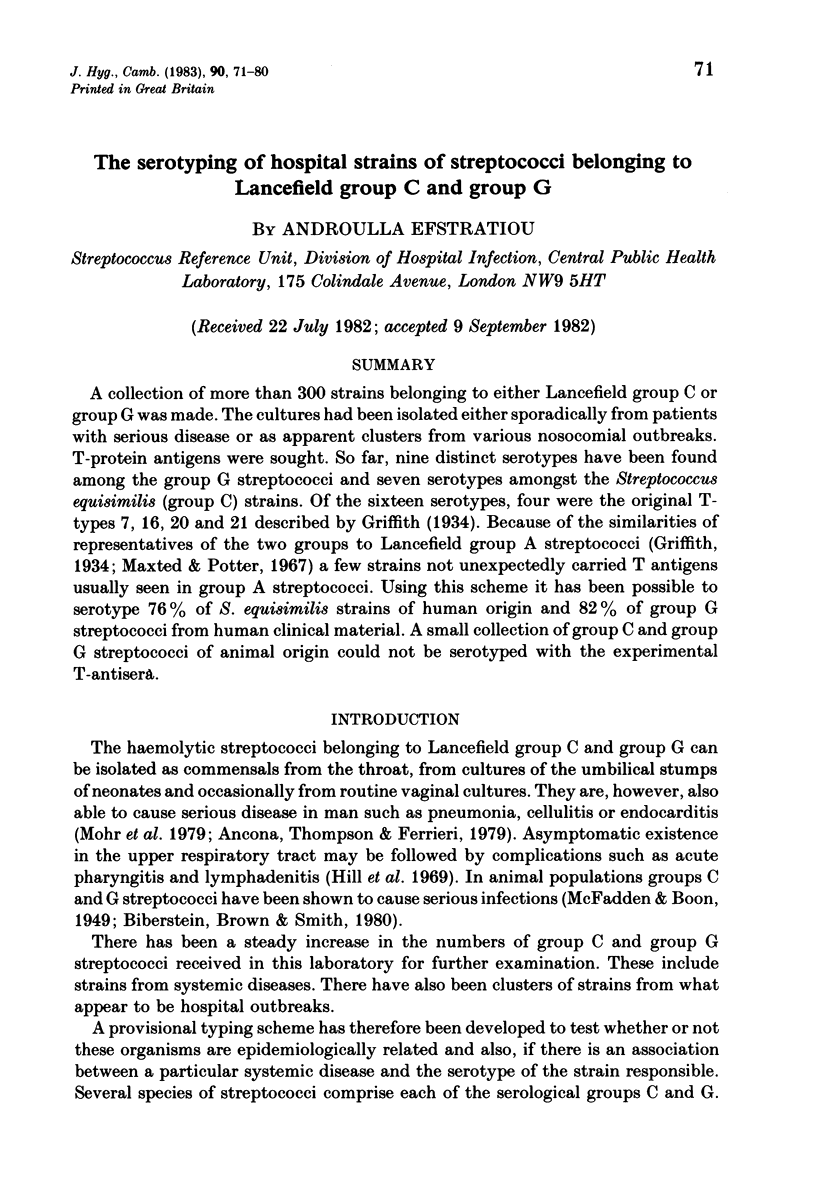Abstract
A collection of more than 300 strains belonging to either Lancefield group C or group G was made. The cultures had been isolated either sporadically from patients with serious disease or as apparent clusters from various nosocomial outbreaks. T-protein antigens were sought. So far, nine distinct serotypes have been found among the group G streptococci and seven serotypes amongst the Streptococcus equisimilis (group C) strains. Of the sixteen serotypes, four were the original T-types 7, 16, 20 and 21 described by Griffith (1934). Because of the similarities of representatives of the two groups to Lancefield group A streptococci (Griffith, 1934; Maxted & Potter, 1967) a few strains not unexpectedly carried T antigens usually seen in group A streptococci. Using this scheme it has been possible to serotype 76% of S. equisimilis strains of human origin and 82% of group G streptococci from human clinical material. A small collection of group C and group G streptococci of animal origin could not be serotyped with the experimental T-antisera.
Full text
PDF









Selected References
These references are in PubMed. This may not be the complete list of references from this article.
- Ancona R. J., Thompson T. R., Ferrieri P. Group G streptococcal pneumonia and sepsis in a newborn infant. J Clin Microbiol. 1979 Nov;10(5):758–759. doi: 10.1128/jcm.10.5.758-759.1979. [DOI] [PMC free article] [PubMed] [Google Scholar]
- Biberstein E. L., Brown C., Smith T. Serogroups and biotypes among beta-hemolytic streptococci of canine origin. J Clin Microbiol. 1980 Jun;11(6):558–561. doi: 10.1128/jcm.11.6.558-561.1980. [DOI] [PMC free article] [PubMed] [Google Scholar]
- Efstratiou A. Preparation of Streptococcus pyogenes suspensions for typing by the agglutination method. Med Lab Sci. 1980 Oct;37(4):361–363. [PubMed] [Google Scholar]
- Hill H. R., Caldwell G. G., Wilson E., Hager D., Zimmerman R. A. Epidemic of pharyngitis due to streptococci of Lancefield group G. Lancet. 1969 Aug 16;2(7616):371–374. doi: 10.1016/s0140-6736(69)92713-5. [DOI] [PubMed] [Google Scholar]
- Lawal S. F., Coker A. O., Solanke E. O., Ogunbi O. Serotypes among Lancefield-group G streptococci isolated in Nigeria. J Med Microbiol. 1982 Feb;15(1):123–125. doi: 10.1099/00222615-15-1-123. [DOI] [PubMed] [Google Scholar]
- Maxted W. R., Potter E. V. The presence of type 12 M-protein antigen in group G streptococci. J Gen Microbiol. 1967 Oct;49(1):119–125. doi: 10.1099/00221287-49-1-119. [DOI] [PubMed] [Google Scholar]
- McLEAN S. J. Identification of strains of Streptococcus pyogenes of Types 5, 11, 12, 27 and 44 by the precipitin test for the T antigen. J Gen Microbiol. 1953 Aug;9(1):110–118. doi: 10.1099/00221287-9-1-110. [DOI] [PubMed] [Google Scholar]
- Mohr D. N., Feist D. J., Washington J. A., 2nd, Hermans P. E. Infections due to group C streptococci in man. Am J Med. 1979 Mar;66(3):450–456. doi: 10.1016/0002-9343(79)91067-2. [DOI] [PubMed] [Google Scholar]
- WILLIAMS R. E. Laboratory diagnosis of streptococcal infections. Bull World Health Organ. 1958;19(1):153–176. [PMC free article] [PubMed] [Google Scholar]


